Kumbarilla Renewable Energy Project (K-REP), based around a 200 MW solar farm in Queensland’s Western Downs, aims to deliver green hydrogen to Korea starting in 2030, following proof of concept achieved by an integrated pilot project, and quickly ramping up to full production for export in subsequent years.
One key point of difference that Kumbarilla has over other solar-farm-meets-hydrogen ambitions in Australia, is that it has been funded since its genesis in 2017 by Korean entities with a vision to fulfil Korea’s Hydrogen Economy Roadmap — which was formulated in parallel with K-REP and released in January 2019 — providing hydrogen produced by renewable sources.
Another key strategic element of this project is that it is situated in the heart of fossil fuel country — amid the unconventional-gas fields of the Surat Basin — with a local workforce trained in gas handling, and a pipeline to gas processing and shipping on Curtis Island.
Smoothing the transition for workers
When Kyu Hong Lee, Strategy Officer for Korea-based, and south-east-Asia-active renewable energy solutions company, Elecseed, started scoping Australian solar-farm opportunities, he met with Trade Investment Queensland and Austrade, both of which he says have been highly supportive of the K-REP project.
He tells pv magazine Australia that in addition to eagerly seeking investment in renewable developments, “They said they are worried that there are many workers and labourers in the mining and traditional energy sectors who want to secure their future jobs.”
Elecseed is one of K-REP’s development partners. Korea Midland Power Company (KOMIPO), which provides some 10% of Korea’s generation capacity and has a global portfolio of more than 16 GW in generation assets either in operation or under development, is the other.
“We are at the tip of industrial transition from conventional energy to renewable energies,” says Hong Lee, and Elecseed and KOMIPO “want to make this transition very smooth, locally and globally, so we are creating jobs for the future in the centre of a traditional energy source.”
Down on the farm
Kumbarilla’s solar assets will be developed in two stages.
The first, a 100 MWp solar farm is expected to be shovel ready by the end of June 2021, and to achieve commercial operation in Q4 of 2022; it will ultimately supply 220 GWh per annum of renewable energy to the National Electricity Market, via a connection currently being negotiated with Powerlink, the Queensland-government-owned transmission system operator.
Some of its output will also be used to feed pilot-scale renewable hydrogen-production facilities, with 250 kW electrolyser capacity that will allow research and development to commence with industrial partners in Australia and overseas.
Robert Saunders, Building Services & Renewables Leader with Calibre Group, which provides diversified services to industry in asset construction and maintenance, is leading the technical engineering advisory team for K-REP. He told pv magazine Australia that the design of Stage 1 is such that it facilitates Stage 2.
“The job’s been master planned around delivering the hydrogen component: hydrogen pads are allocated, there’s water provision, roadways, everything we need to get to that end goal.”
K-REP Stage 2 will add a further 100 MWp of solar generation — commencing in 2023 — alongside utility-scale green hydrogen production facilities, with 80 MW of electrolyser capacity.
The Kumbarilla website explains, “After years of R&D with key industrial partners on site, the 2nd stage solar farm will power this utility scale H2 production facility. Green H2 from the 2nd stage will be used for gas blending, importing overseas, local consumption for mobility, or energy storage for future use in power grid and gas pipeline.”
Local workers will be prioritised during construction of the solar farm which will create around 145 jobs; while maintenance and operation of the asset and the hydrogen plant are expected to generate 480 jobs.
A word from our sponsor country
Korea’s Hydrogen Economy Roadmap, is currently “more focused on economic growth and industrial competitiveness than climate change objectives”, commented an October 2020 report — Focus on hydrogen: Korea’s new energy roadmap — by international law firm Clifford Chance.
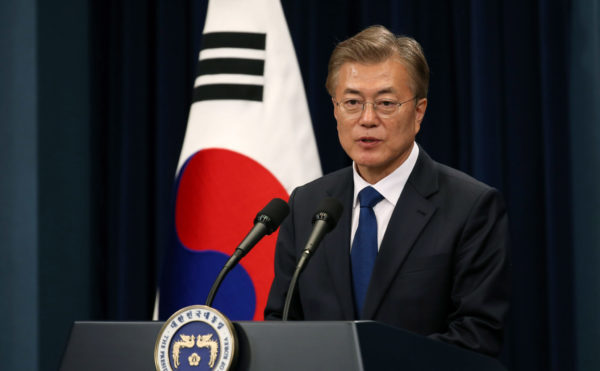
Image: Republic of Korea/Flickr
But in October this year, Korea’s President Moon Jae-in also pledged to achieve carbon neutrality, or net-zero emissions, by 2050; an announcement that came on the global-warmed heels of Japan’s commitment to the same goal, and China’s commitment in September to go net zero by 2060. The Roadmap and pledge are not incompatible.
The 2018 study that preceded the Hydrogen Economy Roadmap, already mooted that a “Hydrogen energy ecosystem can close [the] gap to 2050 CO2 emission reduction target by 40%”, by helping to decarbonise otherwise difficult to decarbonise sectors, such as heavy transport, buildings and industry, and reducing local emissions.
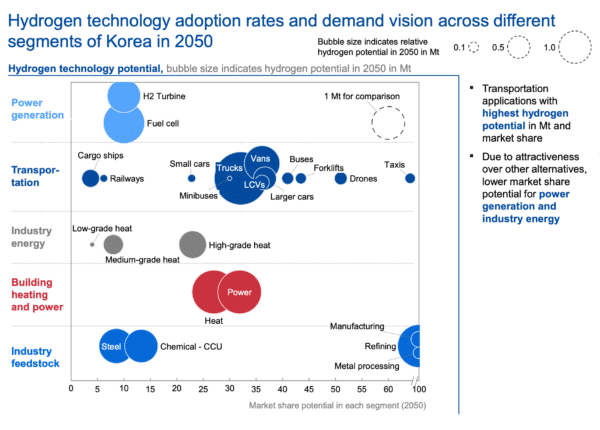
Image: Hydrogen Coalition Members Study
The Roadmap itself sets Korea and its car manufacturers, such as Hyundai, on the highway to hydrogen fuel cell electric vehicles (FCEVs) over battery-powered electric vehicles (EVs), with 2040 production targets of 6.2 million passenger FCEVs including taxis; 60,000 fuel-cell-powered buses and 120,000 trucks; along with 1,200 hydrogen refuelling stations nationwide. It also calls for the supply of 15 GW of hydrogen fuel cell capacity for electricity production by 2040.
In December 2019 Korea also announced three hydrogen pilot cities, which will host projects such as producing green hydrogen using electricity from tidal power, deployment of FCEV buses and forklifts and construction of hydrogen-fuel-cell-powered housing.
Turning black and blue into green
Hong Lee says the K-REP developers believe that “by 2030 the demand for hydrogen in Korea and Asia will exceed the supply produced from byproducts or gas reformation, and also, to reduce gas emissions and CO2 we will have to use green hydrogen instead of black or blue hydrogen.” He adds that Australia will become an important source of green hydrogen — “that’s why we chose Australia for our first project”.
Saunders anticipates that “there’s going to come a tipping point in Australia, where the commercial economics of selling electrons will be less valuable than using them to create hydrogen”; by then, he says Kumbarilla and future Elecseed projects will be well placed to switch the bulk of their output to H2 production, for either export or local consumption.
Kumbarilla’s timeline to 2030 also allows for development of secure transportation methods for hydrogen.
Danny Touma, Lead Financial Advisor in Energy, Water and Waste, and a Director, at PwC Australia, told pv magazine Australia that the biggest change in the hydrogen supply chain over the coming 10 years will be in “the focus on how to convert the hydrogen to be sent overseas”.
Hong Lee says major customers for hydrogen in Korea, such as Hyundai and steelmaker POSCO, talked in November at the virtually held 41st Australia-Korea Business Council meeting about ammonia as the preferred form in which to transport hydrogen, but, he believes that, “liquefied hydrogen will be the better solution”.
Saunders adds, “What we are doing now as a nation with LNG from these gas fields in the middle of Queensland or New South Wales, we can do with green hydrogen — so that transition from a fossil fuel-based energy supplier to a green fuel supply is real.”
Touma’s PwC division is the financial advisor on K-REP, providing strategic financial and commercial advice to the project.
“I think it’s well considered and has great potential compared to some other hydrogen projects, a large part of that is because of the sponsors” he says, referring to Elecseed and KOMIPO.
“The success of hydrogen export projects will largely depend on being able to sell the product,” says Touma, “and having two well-regarded Korean sponsors is a huge leg up to enter those markets — that’s a major differentiating factor for this project.”
This content is protected by copyright and may not be reused. If you want to cooperate with us and would like to reuse some of our content, please contact: editors@pv-magazine.com.
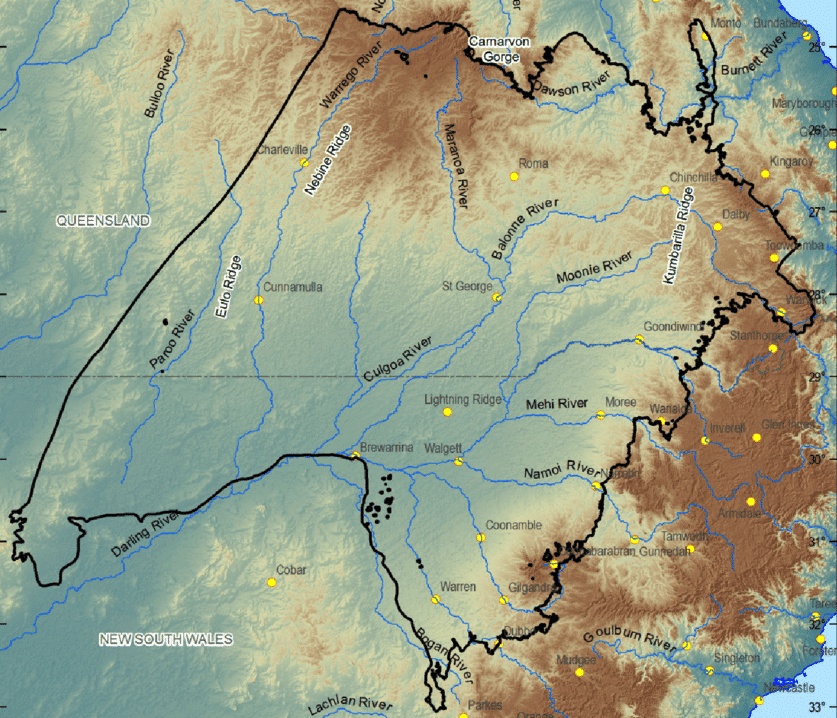




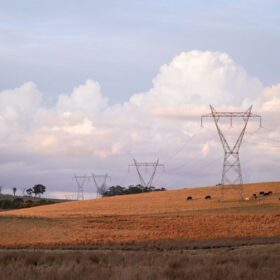
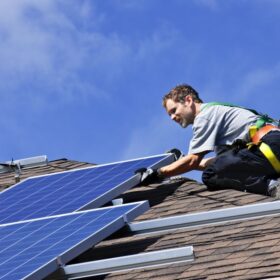
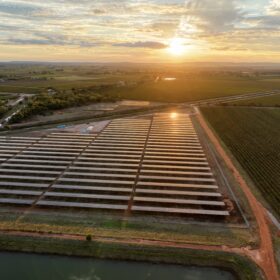
By submitting this form you agree to pv magazine using your data for the purposes of publishing your comment.
Your personal data will only be disclosed or otherwise transmitted to third parties for the purposes of spam filtering or if this is necessary for technical maintenance of the website. Any other transfer to third parties will not take place unless this is justified on the basis of applicable data protection regulations or if pv magazine is legally obliged to do so.
You may revoke this consent at any time with effect for the future, in which case your personal data will be deleted immediately. Otherwise, your data will be deleted if pv magazine has processed your request or the purpose of data storage is fulfilled.
Further information on data privacy can be found in our Data Protection Policy.